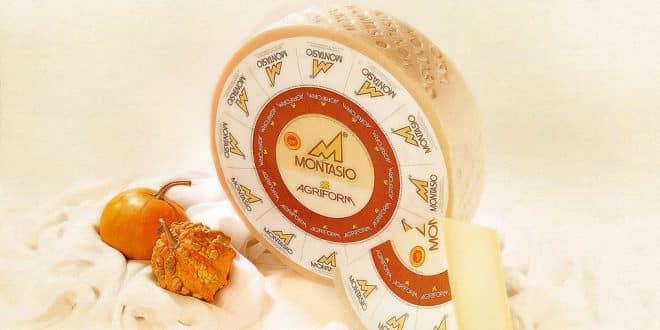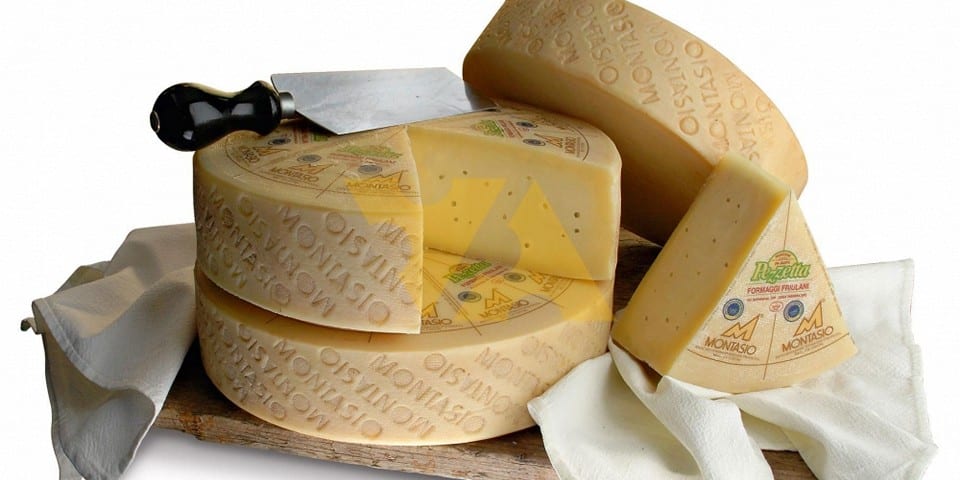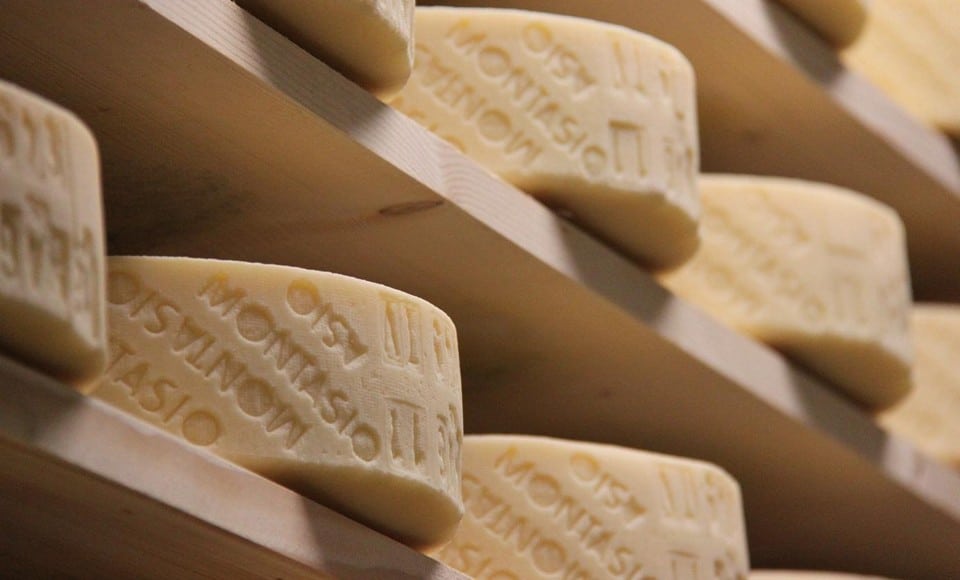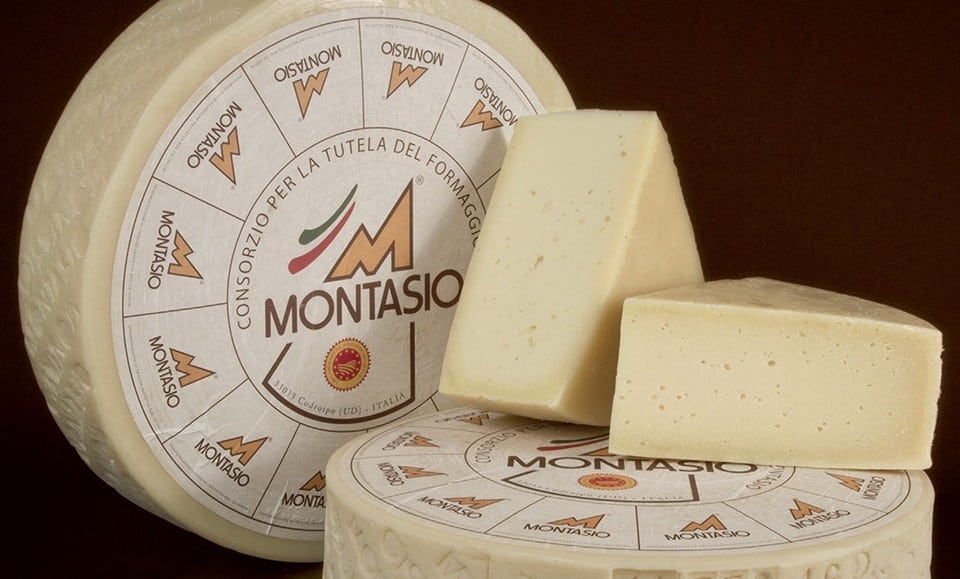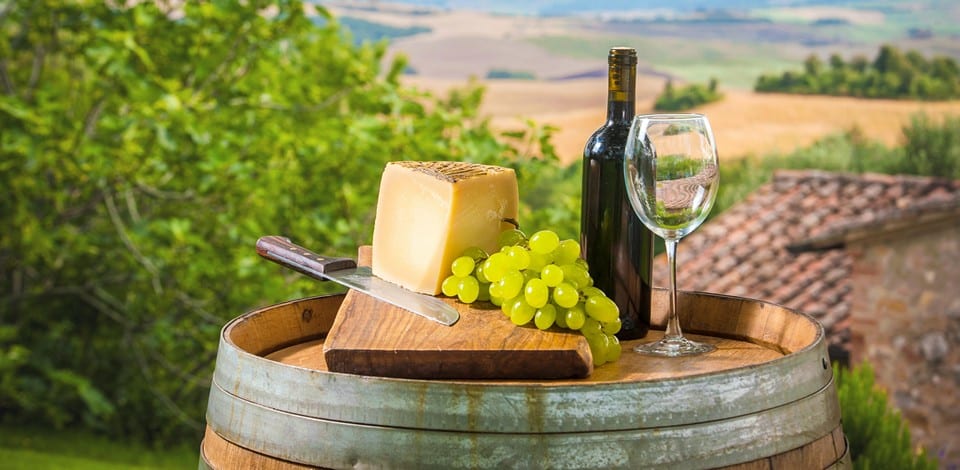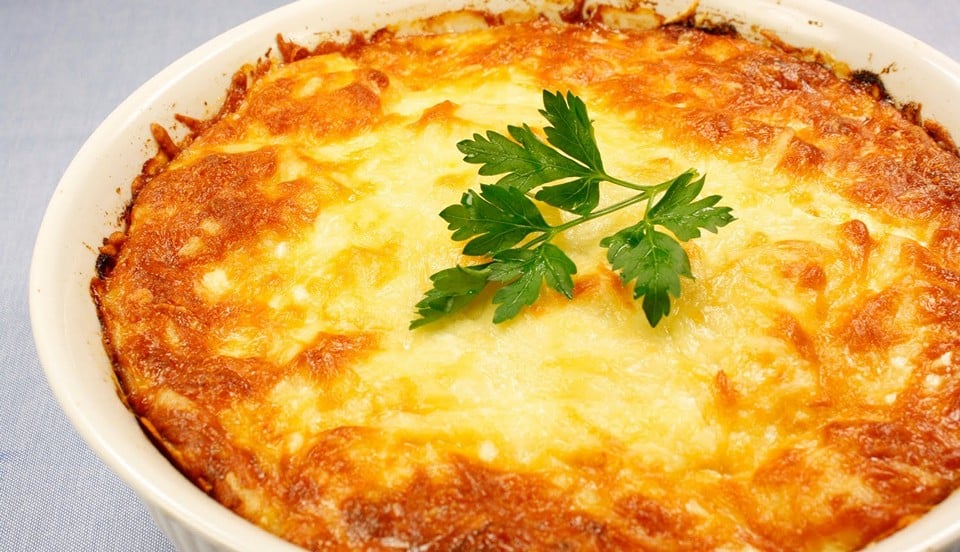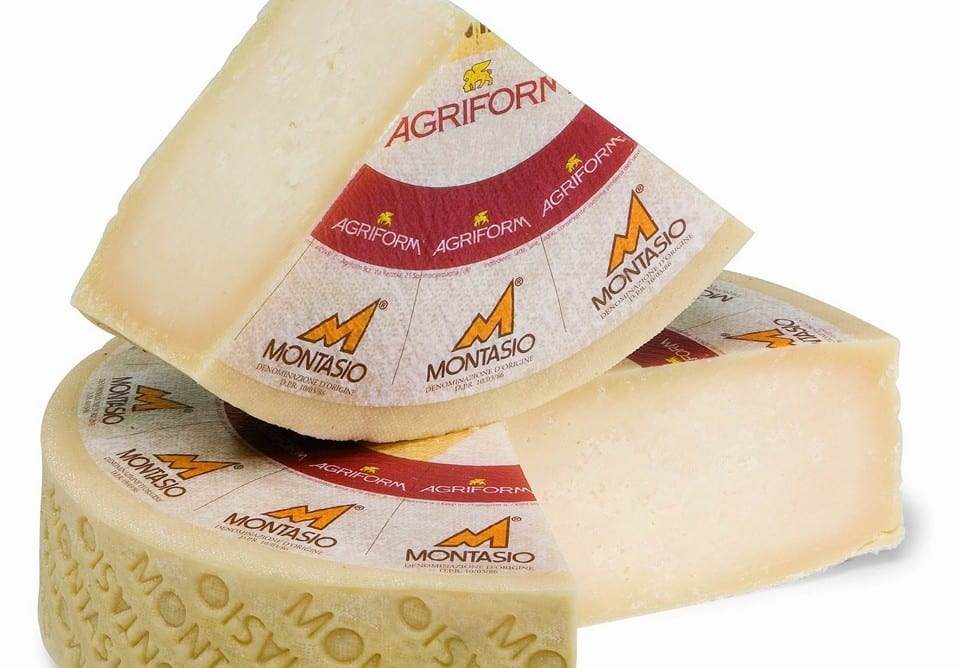Montasio – a typical representative of the Italian Alpine cheese family. Its history spans several centuries, and its production techniques carefully preserve age-old traditions. These merits have allowed the cheese to become part of the DOP (Protected Designation of Origin) products. Let me fill in the gaps of your knowledge about Montasio with the most essential information.
Page Contents
History
Montasio came into existence at the beginning of the second millennium as a cheese suitable for long aging. Its recipe was developed by Benedictine monks around the year 1200 in the area of Moggio Udinese, with the aim of utilizing surplus milk. It was named after Mount Jôf di Montasio, near which it was born.
Soon after its development, the cheese-making technique spread throughout the Friuli-Venezia Giulia region. The first documented mention of “Montasio” cheese appears in price lists for food products in the city of Udine, dated August 22, 1773. The cost of Montasio was significantly higher than that of other types of cheese, priced at 19 soldi per pound. Since then, the product has been mentioned in all market documents of the northeastern part of Italy.
By 1880, the first cooperative dairy plants for Montasio production were established. On March 16, 1987, the Italian Ministry of Agriculture and Forestry issued a decree subjecting the production of the cheese to strict control and management.
In June 1996, Montasio was granted the status of a Protected Designation of Origin (DOP) product.
Technology
Despite industrial progress, the manufacturing process of Montasio cheese has remained largely unchanged. Currently, cheese production takes place in two regions of Italy: Friuli-Venezia Giulia and Veneto.
Cow’s milk is transformed into cheese using gentle methods that do not harm the natural milk microflora. The traditional technique involves using both morning and evening milkings. The evening milk is set aside for curdling, and then fresh morning milk is added to it. This mixture is placed in copper vats, where a rennet obtained from the stomachs of newborn calves is added, and it is heated to a temperature of 32-34 degrees Celsius (89-93 degrees Fahrenheit).
After approximately 20-25 minutes, a curd forms, which is then cut into rice-sized granules using a special tool called a “lyre.” The resulting granules should have the size of a grain of rice.
Next comes the heating stage. The temperature of the curd is gradually increased while continuously stirring, reaching 44-46 degrees Celsius (111-115 degrees Fahrenheit). After about 25 minutes, the curd is extracted and placed in molds labeled with the name of the cheese factory and the production date. After the whey has drained off (after 24 hours), the cheese heads are placed in a brine solution (a saltwater solution) for 2 days. Following this, the cheese goes through a dry salting stage and is then transferred to special aging rooms.
Characteristics and Varieties
Montasio cheese is a semi-hard cheese made exclusively from cow’s milk collected in the production region. The average weight of the cheese heads is 6-8 kg (13-18 lbs). The cheese has a cylindrical shape with a diameter of 30-35 cm (12-14 inches) and a height of 8 cm (3 inches). The minimum fat content in the dry matter is 40%.
The texture of the cheese is compact, with a white or light yellow color and evenly distributed small holes. The rind starts off smooth and elastic, light brown in color, but as it ages, it becomes grainy, brittle, and darker, just like the cheese itself.
Montasio cheese is produced in three varieties:
- Montasio Fresco: This cheese is aged for 2 to 4 months. It has a mild, creamy, harmonious taste reminiscent of alpine milk.
- Montasio Mezzano: Aged for 5 to 10 months, this cheese has a fuller, more pronounced flavor.
- Montasio Stagionato: Aged for over 10 months, this cheese has a rich, buttery taste with a slight hint of sharpness. The eyes (holes) in mature Montasio cheese usually disappear. Cheese aged for more than 18 months is called Stravecchio and has an exquisite, spicy flavor. Sometimes, this version is considered a fourth variety.
Montasio cheese can be distinguished from other cheeses by the diagonal marking “Montasio” on the sides.
What do They Eat With
Montasio cheese is extremely versatile in the kitchen, and its usage depends on the age of the cheese.
Fresco and Mezzano varieties can be enjoyed on their own or in sandwiches. They can be added to salads, savory strudels, pies, and other baked goods. These cheeses complement fresh vegetables and are excellent for preparing meat dishes, pasta, and polenta.
Fresh Montasio is often enjoyed as an aperitif with white wines such as Pinot Bianco and Chardonnay. Montasio of medium aging pairs exceptionally well with red wine varieties like Merlot.
Montasio Stagionato is commonly used grated. It is used to dress pasta, soups, dumplings, and ravioli. It is preferably paired with robust, red wines such as Raboso del Piave.
Remember to reduce the amount of salt if you plan to add Montasio to your dish.
And, as always, let’s not forget an original recipe made from simple ingredients.
«Montasio» Cheese Tortino
The components of the tortino (1 serving), which resembles a thick pancake, are quite simple:
- 200 grams of Montasio cheese
- 1 medium onion
- 1 potato
- Butter and vegetable oil for frying
- Salt and pepper to taste.
First, boil the potato with its skin on. Then thinly slice the onion and sauté it in a pan with a small amount of butter and vegetable oil. Peel the boiled potato, grate it coarsely or cut it into thin strips, and add it to the pan with the onions. Season with salt and pepper, cover the ingredients and let them mingle flavors. Next, evenly distribute the coarsely grated Montasio cheese over the mixture and cook over low heat until the cheese forms a beautiful golden crust. This tortino can be served with fresh or roasted vegetables.
Caloric Content and Nutritional Benefits
Montasio cheese belongs to the category of cheeses with relatively high fat content. Its caloric content reaches up to 396 kcal per 100 grams of cheese. The nutritional value of the product is as follows:
- Protein: 26g
- Fat: 32g
- Carbohydrates: 0g
Consumption of Montasio cheese should be coordinated with healthcare professionals for individuals with excess weight, diabetes, and serious cardiovascular diseases. This is due to its high fat content and relatively high cholesterol content (100mg per 100g). Those with high blood pressure should also avoid excessive consumption of the cheese due to its sodium content (2.3g of sodium per 100g).
The recommended portion of cheese for a healthy adult should not exceed 50g per day.
If we disregard the minor drawbacks that are common to many dairy products, Montasio cheese has evident advantages. A 50g portion of cheese provides the following benefits to your body:
- 15% of the recommended daily intake (RDI) of protein, which is essential for the human body.
- 47% of the RDI of calcium, a crucial component for the health of bones, teeth, and muscles.
- 43% of the RDI of phosphorus, which helps maintain the integrity of dental tissue throughout life.
- 10% of the RDI of zinc, an element involved in the functioning of all the body’s systems.
- 20% of the RDI of vitamin A, an important factor for maintaining sharp vision and healthy skin.
- 15% of the RDI of vitamin B2, which plays a role in the functioning of the visual system, digestive system, and contributes to the elasticity and healthy appearance of the skin.
Price in Italy
To purchase authentic Montasio without lengthy searches, you need to travel to northern Italy. The older the variety, the higher the cost.
The information about Montasio has been successfully loaded. Enjoying a taste of genuine mountain cheese while admiring the view of the Alps is an excellent option for relaxation. Live peacefully, eat light, travel fully, and remember: “Conquering the Alps is a great achievement, and you can confidently enjoy Montasio!”
Interesting Facts about Montasio
- Montasio cheese, originating from the northeastern region of Friuli Venezia Giulia in Italy, has a history that spans over three centuries. It was first crafted by monks in the Montasio plateau, who used their unique cheese-making techniques to create this exceptional cheese.
- Montasio cheese is made exclusively from raw cow’s milk, harvested from cows that graze on the lush pastures of the Friulian Alps. The pristine environment and high-quality milk contribute to the cheese’s rich and complex flavors.
- The aging process of Montasio cheese is crucial to its development. It undergoes a minimum aging period of two months, but some varieties can be aged for up to two years. As it ages, Montasio develops a firmer texture and a deeper, nuttier flavor, offering a range of taste experiences for cheese enthusiasts.
- Montasio cheese has a distinct cylindrical shape with concave sides, reminiscent of a large wheel. The unique shape allows for more efficient aging and enhances the cheese’s distinctive taste and texture.
- Montasio is a versatile cheese that can be enjoyed in various ways. It can be grated over pasta dishes, melted into creamy risottos, or savored on a cheese platter alongside fruits and nuts. Its complex flavors make it an excellent choice for both cooking and enjoying on its own.
- Traditionally, Montasio cheese was aged in cellars known as “fogolârs,” where the cheese wheels were stored near a fireplace to develop their unique flavor. This traditional aging method added a subtle smokiness to the cheese, enhancing its complexity and character.
- Montasio cheese has gained recognition and protection through the PDO (Protected Designation of Origin) status. This certification ensures that the cheese is made according to traditional methods and originates from the designated region, guaranteeing its authenticity and quality.
 Italy for me From Italy with love
Italy for me From Italy with love

